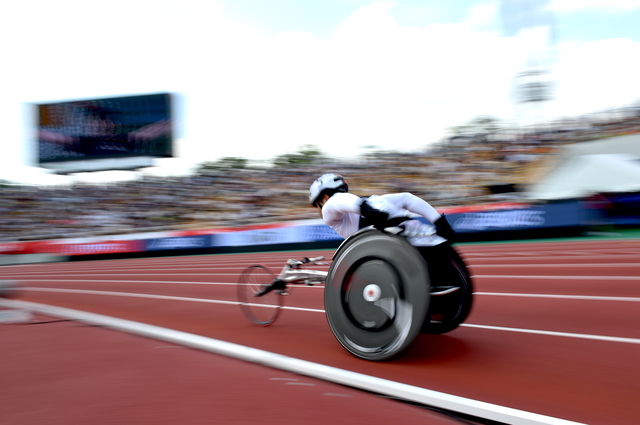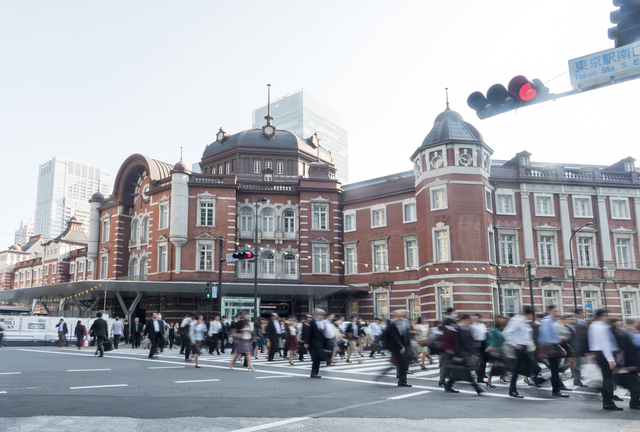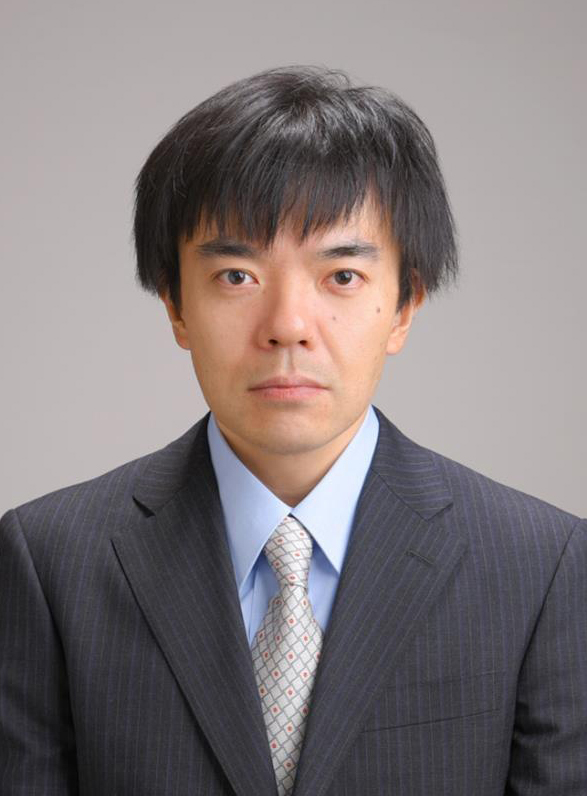The Men Supporting the Paralympians ―The struggle of the engineers behind the evolution of prosthetics
In June of this year, the 26th Japan Para Athletics Championships took place at Denka Big Swan Stadium in Niigata. Due in part to this being the last major event in qualifying for the Rio Paralympics, the press area was full of media teams wearing photographers bibs.
The jumbled rows of camera lenses were pointing at the likes of Yamamoto Atsushi (34), who set a world record of 6.56 m in the men’s long jump in the T-42 class (single above-knee amputation or equivalent), Nakanishi Maya (31), who holds the Japanese and Asian records in the women’s long jump in the T-44 class (single below-knee amputation or equivalent), and Takakuwa Saki (24), who finished seventh in both the women’s T-44 100 and 200 meters at the 2012 London Paralympics. The championships featured a steady stream of athletes with prosthetic limbs who have become well-known in the media.
They all compete using sporting prosthetics in place of their missing legs, consisting of a “socket” that fits over their remaining limb with a carbon “spring” underneath.
At the IPC Athletics World Championships in Doha in October last year, German athlete Markus Rehm (28) took off from the spring on his right leg and jumped 8.40 m in the T-44 long jump, longer than the winning jump recorded at the London Olympics. Heralded as the Paralympian closest to Olympic medalist standards, Rehm is attracting a great deal of interest due to a combination of his own physical abilities and the evolution of the sporting prosthetics he uses.
Usui Fumio (61) was in the crowd for the race in which Onishi Hitomi (39), who was a reserve for the London Paralympics, set a new Asian record of 16.90 seconds in the T-42 women’s 100 meters. He found the experience deeply moving.
“I got a real sense of just how much the environment surrounding disabled sports has changed, compared to the days when the only people watching would be those involved and family members. Watching athletes running and jumping on their prosthetic legs, you almost start to believe that the prosthetics have been an integral part of their body all along. Obviously that’s not the case. As well as having to deal with the loss and pain of losing a limb, and going through the difficult rehabilitation process, these are the handful of people with prosthetic limbs who have also dedicated themselves to endless training taken on the challenge of becoming athletes.”
As a charismatic prosthetist himself, Usui is not unused to being in front of the television cameras. Now in his 60s, he still has vivid memories of the time 27 years ago when disabled sports were just taking their first key steps in Japan.
First “steps”
After dropping out from a private university in Tokyo, followed by a spell drifting between jobs such as truck driver, bartender and street vendor, Usui started down the path towards making prosthetics in 1984, at the age of 28. Having gone along to a vocational training college with an eye to getting a regular job, he spotted a poster advertising a prosthetics course.
The moment he laid eyes on the word “prosthetics,” a distant memory stirred in the back of his head. It was back when Usui was a sixth grader at elementary school. His teacher was suddenly hospitalized with a condition called “giant cell tumor.” When she came back to class six months later, she told her students “my left leg is now a prosthetic leg.”
When Usui got to touch his teacher’s prosthetic leg through her trousers, he remembers it feeling “like a robot’s leg.” That sensation has lingered in his right hand to this day. Wondering if seeing that poster was somehow fate, Usui decided that he wanted to become a prosthetist.
Several days later, he visited the Tetsudou Kousaikai Prosthesis Support Center in the Higashi-Nakano area of Tokyo, interested to see where prosthetics were made for himself. By coincidence, they happened to have an opening for a prosthetist. That was a coincidence that changed Usui’s life. In a highly unusual turn of events, the center he had merely gone to visit offered Usui a job, and just like that, he started work as an apprentice prosthetist.
The Prosthesis Support Center is the only facility in Japan to handle everything from examining and treating people who have lost limbs due to illness or an accident, through to making prosthetics and providing rehabilitation.
“If I had gone to the vocational college, I would have learnt the basics of making prosthetics, but it would have taken a long time. So I figured that this was a heaven-sent opportunity,” recalls Usui. As he began his onsite training in making prosthetics, he learned techniques from senior colleagues, whilst at the same time taking in specialist medical knowledge, including mechanisms and functions of the human body. As a result, from his third year at the center, Usui was left to deal directly with patients on his own, handling everything from preparing molds for sockets through to finishing prosthetics.
In his fifth year after becoming a prosthetist, Usui received a shock when he got hold of a US-published magazine containing a special feature on disabled people. The article included photos of people with prosthetic legs enjoying activities such as jogging, mountaineering and water skiing.
At that time, the patients that Usui was working with were regarded as having completed rehabilitation once they were able to walk in a straight line on their prosthetic legs. The concept of running on prosthetics simply didn’t exist in Japan back then.
“Personally, I don’t have any experience of losing a leg or living with a prosthetic. All I could do was to imagine what it was like,” recalls Usui.
“In movies, you often see scenes where there’s a couple running along a beach, then they share an embrace. I wondered if people with prosthetic legs might find scenes like that upsetting. I thought, if I could just enable people to run on prosthetics, there would be no need for scenes like that to get them down anymore. I thought that would give them hope for the future and help them to live more positively.”
Almost immediately, Usui began requesting information on sporting prosthetics from overseas and placing special orders from manufacturers and wholesalers where he had contacts, asking to order the same parts that he had seen in the magazine, so that he could start making his own sporting prosthetics.
He was convinced that it was possible for people living with prosthetics in Japan to run.
To prove this theory correct, Usui contacted a 27-year-old woman called Yagishita Takako, who had an above-knee prosthetic right leg. Not only did she have positive outlook, but Usui also reasoned that, if he could get a woman running first, male patients would want to follow suit.
One day in 1989, in the narrow, dimly-lit corridors of the Prosthesis Support Center, Usui met with Yagishita.
“Try moving your leg as far forward as possible. That’s fine, you will definitely be able to run.”
Yagishita heard those words several times over, but she struggled to take that first step. As soon as she extended her right leg forward, she couldn’t shake the sense of anxiety that her replacement knee joint would bend and she would fall over.
What clinched it for Yagishita was the fact that Usui spent almost half an hour by her side.
It may have been four steps or five. In terms of distance, they probably didn’t even make it five meters.
Yagishita looked back after putting one foot slowly but surely in front of another and a tear ran down her cheek. Seeing that tear, Usui made up his mind. “If I can make her run, it will bring a smile to her a face and restore her confidence.” His vision certainly proved to be correct.
The evolution of prosthetic athletes
Athletes with amputated limbs became eligible to participate in the Paralympics from the 1976 games in Toronto. Although the name “Paralympic” had been used since the Tokyo games in 1964, the term “para” actually came from the word “paraplegia,” referring to the condition of being paralyzed from the waist down. As a result, most athletes used to compete in wheelchairs. It wasn’t until the 1988 games in Seoul that this was replaced with the word “parallel” and the games clearly defined as a parallel to the Olympics.
Having embarked on their project to run on prosthetics the following year, Usui and Yagishita had relocated exercises to local parks and training grounds. The number of patients participating in training began to increase one or two at a time, as hoped. By 1991, Usui had established “Health Angels” as Japan’s first athletics club for athletes with prosthetics. The club’s name took its cue from the well-known US motorcycle gang Hell’s Angels in an effort to appeal to members of the public, combining a rebellious streak with a sense of humor and a challenging spirit.
The club’s first training session was attended by five people. The fact that Japan had produced its own prosthetic Paralympians a mere ten years later no doubt came as something of a surprise even to Usui himself.
Kojo Akihiro (then 17) and Suzuki Toru (then 20) were the first to take the stage, entering the men’s T-42 100 meters and the men’s T-44 high jump respectively at the Sydney Paralympics in 2000.
They were followed by Saito Mami (then 22), who became the first female Japanese prosthetic athlete to enter the Paralympics at the Athens games. Along with Nakanishi, Takakuwa and Onishi, all of whom are medal hopefuls at the Rio Paralympics that opened on September 7, these are all prosthetic athletes who discovered the joys of running after meeting Usui. Suzuki, who finished sixth at the Sydney games, became the first Asian prosthetic jumper to clear the bar at two meters, and has now appeared at five consecutive Paralympics including Rio. Usui himself accompanied Kojo and Suzuki to the Sydney games, and has flown over to three Paralympics in succession since the Athens games in his role a mechanic to Team Japan.
“Making and adjusting prosthetics for top athletes really helps when it comes to making prosthetics for regular patients too,” explains Usui. “Strength training causes athletes’ muscles to develop in different ways. You’ve got to make adjustments along the way, to the angle of the socket where it attaches to the body for instance, or the length of the prosthetic. The more you start focusing on an athlete’s performance, the more detailed the adjustments to their prosthetics become. You can make use of every little bit of that expertise and experience when making or adjusting everyday prosthetics for regular people, or when communicating with patients.”
The materials used in prosthetic components are rapidly evolving too, in an effort to develop even higher performance sporting prosthetics.
Whereas sockets used to be made from fiberglass, they are now made from lighter yet stronger materials such as polycarbonate and carbon fiber. The bars that support the foot have gone from stainless steel to aluminum, and are now most commonly made from titanium alloy. The springs were originally metal but are now made from around 50 layers of pressure-hardened carbon fiber.
For the most part, the parts used in sporting prosthetics have always been manufactured overseas. The majority of those used by Japanese athletes are made from components ordered from catalogs published by either Ottobock, a German company established to assist wounded soldiers following World War One, or Össur in Iceland.
This approach has one clear drawback however.
“At major events like the Paralympics, athletes from advanced countries use the very latest parts developed by manufacturers in their own countries, parts that aren’t yet commercially available. In some cases, these new parts boast such impressive performance that they put Japanese athletes using existing products at a disadvantage,” comments Usui.
Over the last few years however, there has been an growing drive to develop sporting prosthetics domestically in Japan too.
One of the factors behind this was the emergence of Oscar Pistorius (29), the South African athlete who was determined to compete at the Olympics despite having below-knee prosthetics on both legs.
Having had both legs amputated at the knee at the age of just 11 months due to a congenital condition, Pistorius won bronze in the men’s T-44 100 meters at the Athens Paralympics and immediately declared his intention to compete at the Beijing Olympics four years later. The International Association of Athletics Federations (IAAF) refused to allow this on the grounds that the propulsive power provided by his carbon fiber prosthetic legs was against the rules of the games. Pistorius objected to this and took his case to the Court of Arbitration for Sport (CAS), which caused a huge stir by overruling the IAAD.
Ultimately, Pistorius was unable to compete at the Beijing Olympics because he failed to meet the standards for qualification. He nonetheless won gold medals in three events at the Beijing Paralympics, in the 100, 200 and 400 meters. Images of his running with his carbon fiber springs led to him being dubbed “Blade Runner” and came as a real shock to many people. Yamanaka Junji (59), prominent industrial designer and professor at the Institute of Industrial Sciences, University of Tokyo, was one of those people.
Designing prosthetics to be beautiful
Yamanaka first laid eyes on Pistorius running while watching the Beijing Paralympics on television.
Having previously worked on industrial design across a wide range of fields, including watches, kitchen utensils and trains, and already renowned for having designed the IC card ticket gates used by JR East’s Suica system, Yamanaka saw Pistorius running and it struck him as “the ideal interaction between man and man-made.”
“The man-made springs became an integral part of his body, as an expression of perfect beauty. As a product designer, I’m constantly thinking about how people and products interact with one another. Seeing that level of cohesion between man and man-made, it felt to me like the pinnacle of man-made functional beauty.”
Working as a professor at the Keio University Graduate School of Media and Governance at the time, Yamanaka began to study prosthetic legs along with the students in his class. He visited the Prosthesis Support Center, which had since relocated from Higashi-Nakano to Minami-Senju, and was shown around by Usui. After seeing where prosthetic legs were made and visiting the rehabilitation facilities, Yamanaka went along to an athletics championships for disabled athletes in the city of Akeo, Saitama prefecture, in November that year.
There were athletes from the Health Angels taking part in the same event. He met prosthetic athletes for the first time and greeted them with a smile, but Yamanaka couldn’t help but feel conflicted as he interacted with them.
“To be completely honest, their prosthetics left me with an almost pained impression. They were just lacking in good design. While the overall form was beautiful, when I looked closely, there were issues with individual parts that I just couldn’t overlook as a designer.”
As well as working on sporting prosthetics, Usui had also been developing “real” cosmetic prosthetic legs covered in silicon so that they looked like actual legs, and had also been planning a fashion show featuring members of the Health Angels. “There are lots of patients who won’t even let their families see their prosthetics. I wanted to dispel negative notions like that, even if only slightly.” In contrast to Usui’s motivation, Yamanaka approached prosthetics from a different point of view and started thinking about how to make them more beautiful.
“People had often decorated the sockets on their prosthetics with flower patterns or characters from their favorite animated series, but nobody had really approached prosthetics from a design standpoint, in terms of making them look beautiful as man-made objects. Even if you try to substitute missing body parts by making limbs that look like the real thing, the technology we have at our disposal is just too different from that used in the human body in the natural world. Imitating the human body is neither functional nor rational. The essential purpose of design is to create something that satisfied the criteria of being both functional and beautiful.”
In March 2009, Yamanaka unveiled the first model of a “beautiful prosthetic leg” called the “Rabbit.” Key features included a silver socket wrapped in gentle curves, and spikes built in to the tip of the spring. Although it was a prototype that he expected to improve over time, his futuristic design captured the imagination of people within the industry. In October that year, Yamanaka’s prosthetic legs were chosen by the Ministry of Health, Labor and Welfare as a project to promote research and development of devices to give a greater degree of independence to disabled people. This led to Keio University embarking on joint industry-academic projects with Imasen Engineering, a domestic manufacturer of parts for prosthetic legs, and with the Prosthesis Support Center.
The prosthetic athlete who assisted Yamanaka and his team during this time was Takakuwa, then still in high school. Having been working to develop “Rabbit Ver.1.0” with the vision of Takakuwa running in mind, it wasn’t until March 2010 that they were able to test the end result. Rabbit Ver.1.0 featured a two-tiered structure whereby the socket, which had previously seemed to give a painful impression, consisted of an inner and an outer layer. Images of Takakuwa running in the new prosthetic appeared across a wide range of media.
In an interview at the time, Takakuwa commented, “prosthetics have always been used for purposes such as welfare or medical care. You would never have thought that a prosthetic leg would be developed from the point of view of industrial design. A prosthetic leg forms part of your body and comes to symbolize who you are. I want everyone to take a look at this cool and beautiful prosthetic, inspired by the vision of everyone who has worked on development.”
Research and development continued after that point, refining the Rabbit until it reached Ver.4.5. It was then, during the 2013 season, that Takakuwa began competing at events in Japan and overseas using the Rabbit.
Envisioning athletes speeding along using the Rabbit at the 2020 Tokyo Paralympics in his head, Yamanaka is confident that “prosthetics with outstanding designs will help people who have lost their legs to feel more positive.”
“We want to change people’s values when it comes to prosthetics, by taking medical devices and adding the concept of design. Changing values is the essential purpose of design after all.”
Turning something lost into an asset
Endo Ken (38) from Sony Computer Science Laboratories (Sony CSL) set up Xiborg as a company developing sporting prosthetics in May 2014. Named as his co-manager was Tamesue Dai (38), who competed in the 400 meters hurdles at three consecutive Olympics and twice won bronze metals at the World Championships.
Having been carrying out research into humanoid robots since university, Endo first began thinking about the function and role of prosthetic legs at high school, when a younger student with whom he played basket ball had to have his left leg amputated due to bone cancer.
When he went to the hospital in an effort to cheer up his friend, he took with him an image of a bipedal robot that a person could operate and move around. His friend had the following response. “I don’t want to move around on a robot. I want to walk on my own two legs.”
Researching humanoid robots takes time. Endo wondered if he could conduct research into the applied use of robotic technology to help his friend right away. With that in mind, he went to study overseas with the Massachusetts Institute of Technology (MIT) Media Lab Biomechanics Group. That was where he would find Professor Hugh Herr, a world-leading authority on robotic prosthetic research. Herr had lost both his legs to frostbite while mountain climbing during his teens. “There’s no such thing as a person with a physical disability. It’s just technology that has the disability.” Inspired by Herr’s words, it was once again an “encounter” with Pistorius that actually got Endo interested in sporting prosthetics.
While the CAS was considering whether or not to allow Pistorius to compete at the Olympics, Herr was working with the University of Colorado to measure how he was running and gather data. The results came as a surprise to Endo. With his two below-knee prosthetics, Pistorius was running using completely different muscles from able-bodied athletes, and was actually running faster than they were. Just as Yamanaka had realized “the very fact of losing something opens up new possibilities” as an industrial designer, Endo began to explore the same notion from the point of view of biomechanics.
“In Pistorius’ case, the physical characteristic of having two legs missing was what gave him the means to run quickly. His prosthetics were supposed to ‘make up’ for his missing legs, but they actually turned out to be tools that enabled him to perform at the highest level. That really made me appreciate how much technology can contribute physically to the human body.”
Tamesue meanwhile retired from competition in 2012 and began branching out into all manner of activities, including as a commentator on television. At the same time, he still had one burning desire at the back of his mind.
“When I was competing, I was always fascinated by how far I could push my own body to compete on the world stage. After retiring, the one thing I kept thinking about was the role of sport within society. Could sport help solve some of the problems we as a society are facing? I figured that there must be something I could do along those lines,” comments the former Olympian, who also happens to be the same age as Endo.
“Once I had decided that I wanted to do something to change society, my interest in disabled sports began to grow. In the 100 meters at the Olympics, it’s incredibly difficult to shave 0.1 seconds off your time. If you start thinking about shaving off time in the Paralympic 100 meters however, then there’s still room for innovation. Even more than the Olympics, the Paralympics offer more scope to realize human potential. I think there is plenty of potential to change society along those lines.”
When they met through a shared acquaintance, Tamesue and Endo got on like a house on fire.
“You could make the highest performance prosthetics in the world, but if the athlete doesn’t understand how to use their body to run faster, they’ll ever break any records.” Endo found in Tamesue a dependable partner who shared this outlook.
Xiborg signed a contract with three athletes entering the London Olympics with below-knee prosthetic legs. They were Sato Keita (25), who holds the Japanese record in the T-44 100 and 200 meters, Haruta Jun (38), who was the first Japanese athlete to run the 100 meters in under 11 seconds on prosthetic legs, and Ikeda Mikio (19). The aim was to see which type of prosthetic and what method of running would enable them to run fastest. Tamesue and Endo focused on sporting performance and set about creating prosthetic legs to suit each athlete’s abilities and potential.
“Although we started out on the basis that able-bodied and prosthetic athletes were completely different, we now provide advice based on the same perspectives as able-bodied athletes,” explains Tamesue.
“As an able-bodied athlete, you feel the sensation of the ground in your knees, and then you feel yourself leaving the ground in the tips of your toes. Athletes running on prosthetic aren’t familiar with those sensations. For them, it feels more like treading down from above. I try to catch the slightest sensations I can get from athletes, and convey them to Endo in precise detail wherever possible.”
Working with Sony CSL, Toray and Toray Carbon Magic, they developed “Xiborg Genesis” sporting prosthetic legs aimed at top athletes. At Oita Para Athletics this year, Sato and the others actually ran using Xiborg Genesis prosthetics.
“If you can replace a disability with technology, it’s no longer a disability. Technology is starting to blur the dividing lines between able-bodied and disabled athletes,” emphasizes Endo. “If a Paralympian comes along and breaks the 100 meters record set by an able-bodied athlete, preconceptions and discriminatory attitudes towards disabled people would change too. We want to use technology from prosthetics like that to produce inexpensive prosthetic legs for developing countries, for instance, or to make products to help the elderly walk, or even devices that disabled people can use for leisure purposes. If you have poor eyesight, you wear glasses. Nobody considers people who wear glasses to be disabled however. This is because glasses have benefited from technology to improve deteriorating eyesight, and have evolved in terms of design too. It is my hope that prosthetic legs will one day reach that point.”
Tamesue shares that same dream and continues to encourage Sato from the sidelines, as he prepares to compete at the Rio Paralympics.
“You can be a hero. Do it to change society’s perceptions of disabled people. Become a hero!”
Looking to the future beyond 2020
In July this year, a new prototype Japanese-made spring for athletes was unveiled to the press. Jointly developed by sports equipment manufacturer Mizuno and Imasen, Usui was once again involved in the project in an advisory capacity.
Almost 30 years on from those first steps, watching disabled athletics events isn’t the only thing that makes Usui aware of how much things have changed.
When he first visited the Prosthesis Support Center, the member of staff who showed Usui round said to him, “you’ve got two legs, so why are you interested in work like this? There must be other jobs…” At that time, most of the prosthetists who worked at the support center were people who had lost their legs in railway accidents.
These days, there are 11 universities and technical training colleges around Japan offering courses to become a prosthetist. There have been major changes from the point of view of those making prosthetic legs, in terms of human resources, the environment and attitudes.
“Sport has become one of the key factors in helping disabled people to integrate into society, and in laying the emotional foundations for society to accept disabled people. No matter who you are, if you have self-confidence, your feelings show through and you want to interact with people more. It’s the same for disabled people. Having previously stayed at home, disabled people are starting to come out of their shell and engage more with the world through sports. This helps to improve understanding towards disabled people amongst those around them too. I don’t want Tokyo Paralympics to be a competition to see who wins the most medals. I want it to be a competition to see how many people can take part,” says Usui.
His words are highly persuasive and have offered a source of hope for the likes of Yamanaka, Endo and Tamesue, as they tread their own paths and focus attention on new approaches. They are the ones who are set to map out a new future for how society should be, in 2020 and beyond.
Translated from “Pararinpian wo sasaeru otokotachi (The Men Supporting the Paralympians.),” Bungeishunju, October 2016, pp. 320-329. (Courtesy of Bungeishunju Ltd.) [October 2016]





